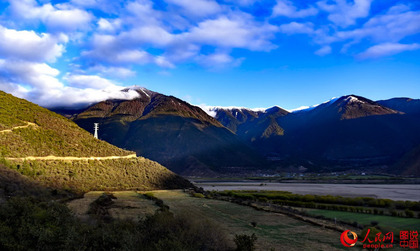Five years of safe and stable operations for electric power road
Key western development projects—the Qinghai-Tibet networking project has been in operation for 5 years, withstanding the cold, low atmospheric pressure, high winds and sand, and other harsh environmental tests. Operations have remained safe and stable, bringing benefits to the people along the “bright, heavenly road” in Qinghai and Tibet.
According to data provided by the National Grid Qinghai Electric Power Company, up to May 6, the Qinghai-Tibet networking project has already conveyed 3.3billion kW/h to Tibet, equivalent to 416,900 tons of standard coal transport, which is a reduction in carbon emissions of 1.03mlillion tons.
Meanwhile, after the second power-up test, the Qinghai-Tibet D.C. power system successfully carried out reverse-carry loads. The Tibet power grid achieved 332 million kW/h of hydropower delivery during the high water level periods, all of which was consumed within Qinghai Province.
“This project has been in operation for 5 years, and it has not only provided a continuous stream of reliable clean energy for the development of Tibet’s economy and society, it has also actively contributed to the improvement of the local ecological environment.” Ju Gaofeng, commander of the Qinghai-Tibet networking project Tsaidam basin converter station maintenance site, said that relying on science and technology to improve management efficiency and the full implementation of the “standardization, specialization, improvement” operation and maintenance model, has provided powerful support for the safety and stability of this project’s operations.
The Qinghai-Tibet networking project is a key western development project. It is also the world’s highest D.C. electricity transmission project and the longest transmission line across frozen ground. Located mostly in a low atmospheric pressure area with a lack of oxygen, cold, high winds, and radioactive hot spots, at an average elevation of 4,500 meters high, the highest elevation point is at 5,300 meters high. More than 900 kilometers of the line are located in areas above 4,000 meters high.
Key western development projects—the Qinghai-Tibet networking project has been in operation for 5 years, withstanding the cold, low atmospheric pressure, high winds and sand, and other harsh environmental tests. Operations have remained safe and stable, bringing benefits to the people along the “bright, heavenly road” in Qinghai and Tibet.
According to data provided by the National Grid Qinghai Electric Power Company, up to May 6, the Qinghai-Tibet networking project has already conveyed 3.3billion kW/h to Tibet, equivalent to 416,900 tons of standard coal transport, which is a reduction in carbon emissions of 1.03mlillion tons.
Meanwhile, after the second power-up test, the Qinghai-Tibet D.C. power system successfully carried out reverse-carry loads. The Tibet power grid achieved 332 million kW/h of hydropower delivery during the high water level periods, all of which was consumed within Qinghai Province.
“This project has been in operation for 5 years, and it has not only provided a continuous stream of reliable clean energy for the development of Tibet’s economy and society, it has also actively contributed to the improvement of the local ecological environment.” Ju Gaofeng, commander of the Qinghai-Tibet networking project Tsaidam basin converter station maintenance site, said that relying on science and technology to improve management efficiency and the full implementation of the “standardization, specialization, improvement” operation and maintenance model, has provided powerful support for the safety and stability of this project’s operations.
The Qinghai-Tibet networking project is a key western development project. It is also the world’s highest D.C. electricity transmission project and the longest transmission line across frozen ground. Located mostly in a low atmospheric pressure area with a lack of oxygen, cold, high winds, and radioactive hot spots, at an average elevation of 4,500 meters high, the highest elevation point is at 5,300 meters high. More than 900 kilometers of the line are located in areas above 4,000 meters high.
Your Comment
Name E-mailRelated News
-
;
-
-

-
Nyingchi:Fairyland on earth
Located in the southeast part of Tibet Autonomous Region, Nyingchi is famous for its splendid scenery and often praised as a fairyland on earth.
-
-
-
-
'Experience western China' event brings new Silk Road to Italy
The event "Experience western China" kicked off in Italy's Milan on Sunday to help people know more about China, especially the northwestern part of the country.
-
-
-

-
Over 100,000 Tibetan antiques digitally documented
Southwest China's Tibet autonomous region has finished making digital records of over 100,000 antiques, local authorities said Monday.
-
Based in Lhasa, Tibet Vista is a Tibet travel agency that specialized in Tibet permit, and Tibet tours for both private and group travelers at a local price!
•4 Days Lhasa City Group Tour from USD 460 •8 Days Everest Base Camp Group Tour from USD 850 •15 Days Mt.Kailash Group Tour from USD 1780 •2016 Tibet Train Tours from Beijing, Shanghai, Chengdu, Xining,etc











